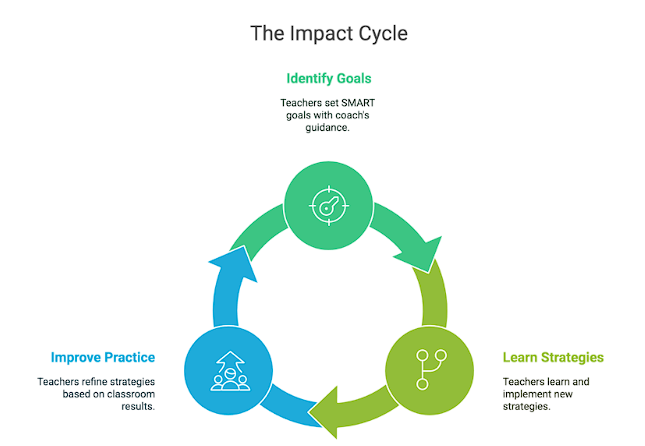The Jim Knight Coaching Model revolutionizes teaching by fostering equal partnerships between coaches and teachers. This article explores its key components, showing how this model supports continuous improvement and better student outcomes.
Key Takeaways
- The Jim Knight Coaching Model emphasizes a partnership between coaches and teachers, focusing on collaborative decision-making and personal goal setting to enhance teaching practices and student outcomes.
- The Impact Cycle, encompassing the stages of identify, learn, and improve, is a practical application of the coaching model that systematically enhances instructional strategies and promotes continuous progress.
- Effective instructional coaching relies on strong communication skills and deep knowledge of teaching methods, enabling coaches to support teachers’ professional growth and foster an environment of trust and improvement.
Understanding the Jim Knight Coaching Model
Jim Knight describes coaching as a conversation between equals—two partners working together to achieve common goals. His coaching model consists of four key components: beliefs, the coaching cycle, coaching skills, and strategic knowledge. This approach is rooted in the philosophy that effective instructional coaching depends on viewing coaches and teachers as equal partners. Knight’s research indicates that teachers are more likely to implement strategies learned in coaching conversations that are rooted in partnership rather than directive approaches.
Facilitative coaches play a crucial role in this model. They encourage open sharing of ideas by listening empathetically and asking powerful questions. This method allows teachers to make most decisions, thereby enhancing the coaching process. Fostering an environment where teachers feel heard and valued, the Jim Knight coaching model cultivates a supportive culture that encourages continuous improvement.
Essentially, the Jim Knight coaching model avoids “telling teachers what to do.” Instead, it empowers teachers to make informed decisions about their own professional learning. This partnership approach leads to more meaningful and sustainable changes in teaching practices, ultimately benefiting student outcomes.
The Impact Cycle: A Core Component

The Impact Cycle is a practical application of the foundational beliefs of the Jim Knight coaching model. This cycle operationalizes the coaching process through three key phases: identify, learn, and improve. The first stage, identify, involves setting a clear goal based on an assessment of the current reality. Coaches often use video tools to gain insights into current teaching practices, which highlights helps in setting specific, achievable identify goals.
The learn phase is where the instructional coach supports the teacher in implementing new strategies to achieve the set goals through a directive approach. This phase is characterized by collaborative learning and the application of new teaching methods to teach effectively.
The final phase, improve, involves confirming the direction, reviewing progress, and planning subsequent actions to refine teaching strategies. This definitive guide ensures that teaching practices are continually being improved upon, leading to unmistakable impact.
The effectiveness of coaching is amplified when teachers and coaches work together to set achievable student focused goals for student learning. Following the structured framework of the Impact Cycle allows educators to systematically enhance their teaching practices, resulting in better student outcomes and a more positive learning environment.
Key Skills for Effective Instructional Coaches
Effective instructional coaching hinges on the development of specific coaching skills, particularly in the areas of communication. Professional development programs aligned with the Jim Knight coaching model emphasize the cultivation of strong listening and questioning techniques among instructional coaches. Active listening allows coaches to fully understand teachers’ perspectives, fostering an environment of trust and collaboration.
Moreover, instructional coaches should possess deep knowledge of effective teaching practices. This strategic knowledge enables them to share valuable insights and strategies with teachers, helping them achieve their professional goals. Coaches need to be well-versed in a variety of teaching strategies and instructional resources to provide the most relevant and effective support.
The combination of strong communication skills and strategic knowledge makes instructional coaches invaluable partners in the educational process. Guiding teachers through reflective conversations and offering expert insights allows coaches to significantly enhance teaching practices and, consequently, student success.
Partnership Principles in Action
The essence of effective instructional coaching lies in the partnership approach, where coaches and teachers engage as equals in the learning process. Key elements of this approach include equality, choice, and active dialogue, which help create a supportive coaching culture. These partnership principles foster equitable interactions among coaches and teachers, making the coaching relationship more productive.
Teachers are more likely to succeed and improve their practices when they feel supported and encouraged by an effective coaching program. In this model, teachers are the decision-makers in their learning process, which enhances their commitment to implementing new strategies. This empowerment leads to a more dynamic and responsive educational environment.
Promoting trust and open dialogue between administrators and teachers, the partnership approach not only improves teaching practices but also positively impacts the overall school culture. This collaborative atmosphere ultimately leads to better student outcomes and a more cohesive school community.
Customizing Professional Learning for Teachers
Customizing professional learning for teachers begins with identifying specific school or district needs through data analysis. This targeted approach ensures that professional development opportunities are relevant and effective. Instructional coaches play a crucial role in this process by helping teachers analyze their current practices, identify areas for growth, and implement changes that benefit students.
In the Jim Knight coaching model, the emphasis is on teacher autonomy, with coaches guiding teachers in making decisions about their own learning goals. This collaborative approach allows teaching strategies to be tailored to better meet student needs. Incorporating culturally responsive pedagogy is also essential for addressing the diverse needs of students.
Customizing professional learning ensures that teachers are equipped with the skills and knowledge they need to succeed. This individualized approach not only enhances teaching practices but also leads to improved student outcomes and overall school performance.
Enhancing Student Success Through Coaching
The ultimate goal of instructional coaching is to enhance student success. The Impact Cycle is designed to partner with educators to improve both student learning and well-being through targeted coaching. Implementing partnership principles can significantly enhance the learning environment and improve school culture.
Instructional coaching fosters a supportive environment that empowers teachers, leading to heightened student achievement. As teachers develop their skills and become more effective in their roles, student expectations and outcomes also increase. This correlation underscores the importance of investing in coaching programs, including an instructional coaching group, that support continuous teacher development.
While administrators may not conduct full coaching cycles with every teacher, they can still promote a culture of improvement by encouraging teachers to set and pursue their own goals. This culture of continuous improvement contributes to overall student success and a thriving educational environment.
Administrator Insights on Coaching Programs
Administrators play a crucial role in the success of instructional coaching programs, including principal leadership. Leveraging the expertise of experienced coaches within the district can enhance training sessions and provide relevant content for professional development. Experienced coaches bring practical insights and real-world examples that resonate with teachers, making the training more impactful.
Additionally, a school administrator can promote a culture of continuous improvement by encouraging teachers to set and pursue their own goals. This encouragement fosters a supportive environment where teachers feel motivated to grow and improve, ultimately benefiting the entire school community.
Continuous Learning for Instructional Coaches
Continuous learning is essential for instructional coaches to stay effective in their roles. Ongoing professional development helps coaches adapt to new teaching strategies and enhance their coaching effectiveness. Workshops provide a platform for coaches to learn about new methods and refine their techniques.
Peer collaborations are another valuable aspect of continuous learning. Sharing knowledge and best practices allows coaches and their colleagues to improve their skills and implement the most effective teaching strategies. Staying updated with the latest coaching practices ensures that coaches can provide the best support to teachers, ultimately leading to better student outcomes.
Incorporating continuous learning into the coaching model fosters a culture of growth and improvement, benefiting both teachers and students.
Implementing the Jim Knight Coaching Model in Schools
Implementing the Jim Knight Coaching Model in schools requires a comprehensive approach. The GROWTH coaching model offers a flexible framework for administrators to guide teachers through meaningful changes and goal achievement. This model emphasizes collaboration, making it easier for teachers to engage in the coaching process.
Effective implementation also requires resources such as training materials and access to professional development workshops. Continuous support and peer collaboration among teachers and coaches are crucial for sustained success factors in education, as presented in the written guidelines, including top instructional resources and articles on staff development practice.
Providing these resources and fostering a collaborative environment enables schools to effectively implement the Jim Knight Coaching Model and achieve lasting improvements in teaching and learning through Corwin Press.
Wrapping Up The Jim Knight Coaching Model
In summary, the Jim Knight Coaching Model offers a powerful framework for enhancing instructional practices and achieving student success. By emphasizing partnership, effective communication, and continuous learning, this model fosters a supportive and collaborative educational environment. Implementing these principles can lead to significant improvements in teaching practices and overall school performance, making a lasting impact on both teachers and students.
Frequently Asked Questions
What are the key components of the Jim Knight Coaching Model?
The key components of the Jim Knight Coaching Model are beliefs, the coaching cycle, coaching skills, and strategic knowledge. These elements work together to enhance effective coaching practices.
How does the Impact Cycle enhance teaching practices?
The Impact Cycle enhances teaching practices by fostering a structured approach where educators set goals, implement targeted strategies, and continuously refine their methods, thereby promoting ongoing professional growth and improved student outcomes.
Why is partnership important in instructional coaching?
Partnership is crucial in instructional coaching as it promotes equality and active dialogue, enabling teachers to feel empowered in their professional development. This collaborative environment enhances learning and teaching outcomes.
How can administrators support instructional coaching programs?
Administrators can effectively support instructional coaching programs by leveraging experienced coaches for training and promoting a culture of continuous improvement while ensuring that necessary resources are readily available for successful implementation.
What role does continuous learning play for instructional coaches?
Continuous learning is essential for instructional coaches as it enables them to stay abreast of new teaching strategies and enhance their methods, ultimately increasing their effectiveness in supporting educators.




